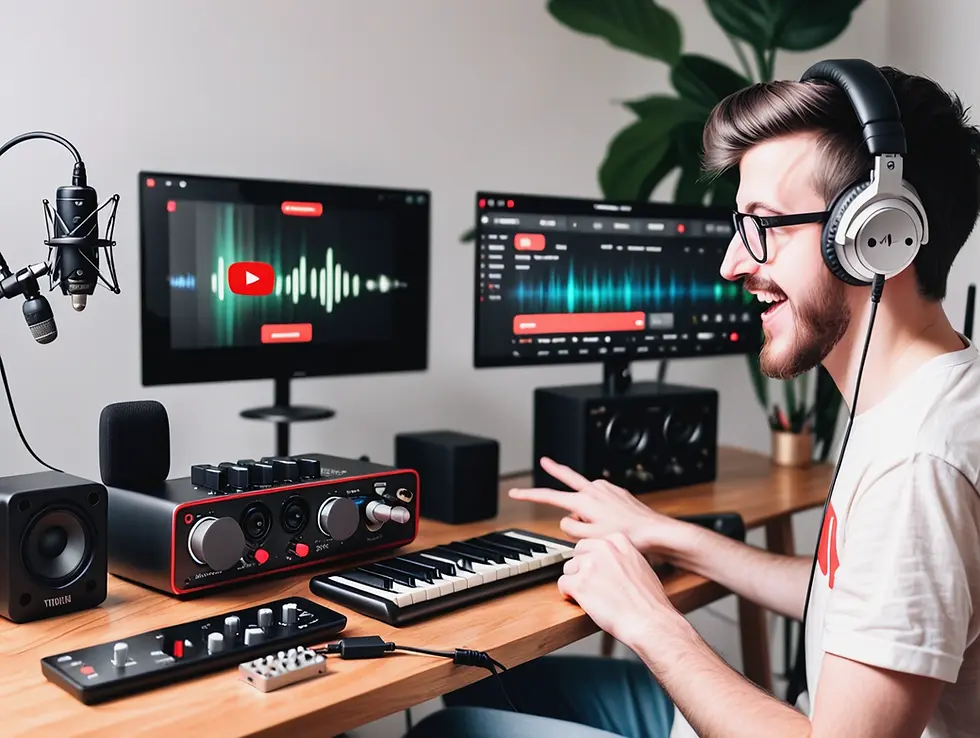Budget Audio Interfaces for Streaming: Top Picks in 2025
- Music Trendz
- Sep 11, 2024
- 3 min read
Updated: Jan 1

Streaming isn’t just about great visuals—it’s about clear, professional audio too. Poor sound quality can quickly drive your audience away, no matter how engaging your content is. This guide covers the top budget audio interfaces that can enhance your streaming audio without breaking the bank, ensuring your viewers stay tuned in.
Budget Audio Interface for Streaming
Quick Links
Elgato Wave XLR – Best for Streamers
Focusrite Scarlett Solo (3rd Gen) – Best Overall
PreSonus AudioBox GO – Best for Portability
Behringer UM2 Audio Interface – Best for Beginners
M-Audio M-Track Solo – Best Budget
Best Features to Look for in a Budget Audio Interface for Streaming
High-Quality Sound with Real-Time Monitoring: Choose an audio interface that ensures clear audio and supports real-time monitoring to prevent delays.
Easy Integration with Streaming Platforms: Opt for an interface that connects seamlessly to Twitch or YouTube, making live streaming hassle-free.
User-Friendly Setup: Avoid technical issues during broadcasts with a simple setup that lets you focus on your content.
Portable and Affordable: Select a durable interface that’s easy to carry and delivers professional sound quality without exceeding your budget.
Top 5 Budget Audio Interface for Streaming in 2024
1. Elgato Wave XLR – Best for Streamers
The Elgato Wave XLR is built for streaming. It offers real-time audio monitoring, making it easy to adjust your sound while live. Its seamless integration with streaming platforms like Twitch and YouTube makes this interface ideal for those focused on high-quality live streaming.
2. Focusrite Scarlett Solo (3rd Gen) – Best Overall
The Focusrite Scarlett Solo delivers studio-quality sound at an affordable price. It’s perfect for streamers looking for crisp audio without too much hassle. Its easy setup and reliable performance make it one of the top picks for both beginners and experienced streamers.
3. PreSonus AudioBox GO – Best for Portability
For streamers on the go, the PreSonus AudioBox GO offers a compact and portable solution. Despite its size, it doesn’t skimp on sound quality, making it a great choice for streamers who need reliable audio while traveling or setting up in different locations.
4. Behringer UM2 Audio Interface – Best for Beginners
If you’re just getting started with streaming, the Behringer UM2 offers the perfect balance between price and performance. It’s affordable and provides decent audio quality for basic streaming setups, making it a solid choice for beginners.
5. M-Audio M-Track Solo – Best Budget
For those on a tight budget, the M-Audio M-Track Solo offers a low-cost solution without sacrificing too much on audio quality. It’s ideal for streamers who want an entry-level interface that’s easy to set up and delivers clear, distortion-free sound.
Top Questions Streamers Ask About Budget Audio Interfaces
Do I really need an audio interface for streaming?
Streamers frequently ask whether an audio interface is necessary. The short answer is yes, if you're looking to enhance your audio quality significantly. Built-in microphones or USB mics typically can’t match the clarity, depth, and control that an audio interface provides, especially for live streaming setups.
What is the best budget audio interface for streaming?
Streamers often look for budget-friendly options that still deliver high-quality sound. Popular budget choices include the M-Audio M-Track Solo, Behringer UM2, and Focusrite Scarlett Solo (3rd Gen), all known for reliability and ease of use.
Can I use a USB mic with an audio interface?
This is another common question. Typically, audio interfaces are designed for XLR microphones, so USB mics aren’t directly compatible. However, there are interfaces like the Elgato Wave XLR that allow streamers to connect mics and other audio sources while maintaining high sound quality.
How does latency affect streaming, and how can an audio interface help?
Latency— the delay between speaking and hearing the sound—can be a big issue for streamers. Audio interfaces with low-latency monitoring help eliminate this delay, ensuring your audio is synchronized with your video during streams.
What features should I look for in an audio interface for streaming?
Key features include real-time monitoring, phantom power (for condenser mics), multiple inputs for additional microphones or instruments, and loopback functionality, which allows streamers to mix audio from their computer with live input.






Comments